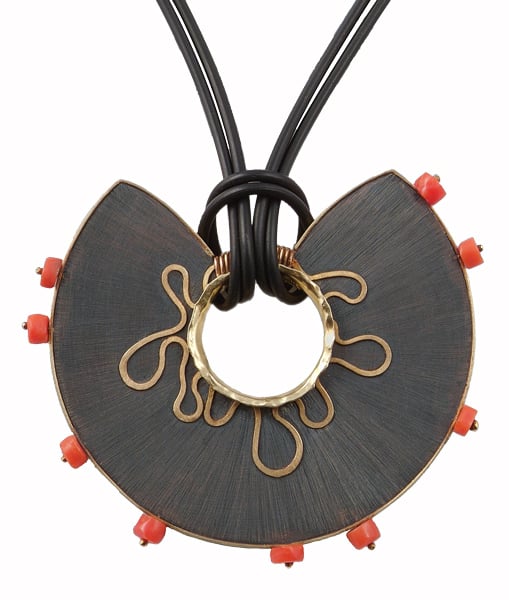Alishan Halebian’s Imperfect Perfection
3 Minute Read
Alishan Halebian's sphere is a metaphor for light and life. Beginning with the concept of a sphere, Alishan Halebian of Alishan in Irvine, California, created a double-sided 65 mm diameter pendant/ring with design elements that are a metaphor for light and life.
A spark begins in the 18k yellow gold center, then moves out through the gold spirals and onto antique Italian coral beads held on by more 18k yellow gold.
First capturing his idea in a rough sketch, he then began work by cutting a perfect circle from 0.9 mm flat sterling silver stock. From the circle, he cut a wedge from the bottom and a circle from the center—about the size of a size 7 ring—leaving a bridge between the two. He hand-textured the sphere with fine lines scratched into the metal with a very sharp tool, beginning in the center and moving outward.
To edge the sphere, Halebian shaped a ribbon of 18k yellow gold wire measuring 0.5 mm thick and 2 mm wide on a mill. He then centered it on the outside edges of the silver, tacked it in place with a laser, and soldered. Also, he wrapped round 0.5 mm rose gold wire—a point of visual interest—around the bridge.
The central circle of light is a ring of 0.3 mm 18k yellow gold formed on a mandrel and inserted into the center hole. Halebian chose very thin metal so he could manipulate and shape it. He works the metal, quenches it, anneals with a torch, bends and pushes the metal into place, and stops to anneal again as needed.
Halebian then gives the edges of the finger hole a hand-hewn appearance by intentionally heating the gold almost to its melting point with a strong blue flame as he continues bending and pushing the metal toward the silver, allowing it to tear in places. "The intention is not a perfect finish," he says. "Nothing is perfect here except the circle itself. I like contrast. When I start with something perfect, I want to add something to it that is not perfect."
The swirls are made next from round 0.5 mm wire, which is annealed and then formed with round nose pliers. "The formation is irregular, but has to go around the circle in the center," says Halebian. "There is quite a bit of bending and forming in certain areas. When you improvise, it's sometimes surprising and comes out really cool." When he attaches the swirls to the silver disk with the laser, some areas tuck under the center ring, so he lifts it as needed and pushes the edge down again, while some areas do not actually touch the silver. Each of the swirl's ends is hidden in the rose gold spiral.
The next part of fabrication brought the most challenges. The nine natural antique Italian coral beads he'd purchased years earlier were different shapes, some thicker and wider, with a hole in the middle. To attach them to the piece, Halebian heated gold pins that would fit inside the beads with a torch to ball up the ends. After marking holes at random locations around the perimeter of the sphere with a Sharpie, he drilled holes the diameter of the wire through the gold band on the edge into the silver sphere. Laying the disc flat, he next drilled holes into the side of the silver disk where the gold band and silver meet, intersecting the other holes. Placing a bead on the pin and inserting it into the hole, he laser tacked the side hole, thus attaching the wire to the silver and keeping the heat about 0.5 mm from the coral. After tacking all nine, he laser welded with silver and repaired the texture. Blackening with liver of sulfur added the final touch onto the textured silver.
"I like things that aren't definite—things that people could interpret in many ways," says Halebian. "Here everything starts at the center with a spark on a dark background so the heat protrudes out of the sphere and you see spots of heat. It can be a metaphor of sun, life, energy, and the universe."
The award-winning Journal is published monthly by MJSA, the trade association for professional jewelry makers, designers, and related suppliers. It offers design ideas, fabrication and production techniques, bench tips, business and marketing insights, and trend and technology updates—the information crucial for business success. “More than other publications, MJSA Journal is oriented toward people like me: those trying to earn a living by designing and making jewelry,” says Jim Binnion of James Binnion Metal Arts.
Click here to read our latest articles
Click here to get a FREE four-month trial subscription.
You assume all responsibility and risk for the use of the safety resources available on or through this web page. The International Gem Society LLC does not assume any liability for the materials, information and opinions provided on, or available through, this web page. No advice or information provided by this website shall create any warranty. Reliance on such advice, information or the content of this web page is solely at your own risk, including without limitation any safety guidelines, resources or precautions, or any other information related to safety that may be available on or through this web page. The International Gem Society LLC disclaims any liability for injury, death or damages resulting from the use thereof.
The All-In-One Jewelry Making Solution At Your Fingertips
When you join the Ganoksin community, you get the tools you need to take your work to the next level.
Trusted Jewelry Making Information & Techniques
Sign up to receive the latest articles, techniques, and inspirations with our free newsletter.
